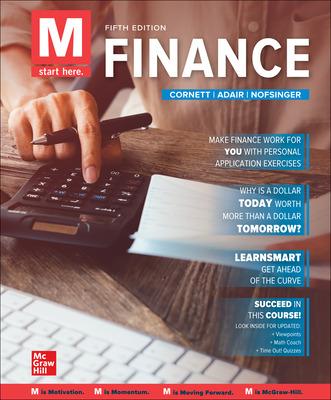Question
CHAPTER 2: 1) Consider the following information for Ball Corp. Selling and administrative expense $ 40,000 Depreciation expense $ 70,000 Sales $ 350,000 Interest expense
CHAPTER 2:
1) Consider the following information for Ball Corp.
| Selling and administrative expense | $ | 40,000 |
|
| Depreciation expense | $ | 70,000 |
|
| Sales | $ | 350,000 |
|
| Interest expense | $ | 30,000 |
|
| Cost of goods sold | $ | 110,000 |
|
| Taxes | $ | 17,500 |
|
What is the operating profit for Ball Corp.?
A) $71,450
B) $90,000
C) $130,000
D) None of the options
2) Candy Company had sales of $320,000 and a cost of goods sold of $112,000. What is the gross profit margin (ratio of gross profit to sales)?
A) 55%
B) 65%
C) 35%
D) 73.3%
CHAPTER 3:
3) A firm's long-term assets = $100,000, total assets = $400,000, inventory = $50,000 and current liabilities = $200,000. What are the firm's current ratio and quick ratio?
A) Current ratio = 0.5; quick ratio = 1.25
B) Current ratio = 1.0; quick ratio = 2.0
C) Current ratio = 1.5; quick ratio = 1.25
D) Current ratio = 2.5; quick ratio = 2.0
|
4) MEGAFRAME COMPUTER COMPANY |
| ||
| Balance Sheet |
| ||
| As of December 31 |
| ||
| ASSETS |
|
| |
| Cash | $ | 50,000 | |
| Accounts receivable |
| 70,000 | |
| Inventory |
| 110,000 | |
| Net plant and equipment |
| 220,000 | |
| Total assets | $ | 450,000 | |
|
|
|
| |
| LIABILITIES AND STOCKHOLDERS' EQUITY |
|
| |
| Accounts payable | $ | 70,000 | |
| Accrued expenses |
| 50,000 | |
| Long-term debt |
| 130,000 | |
| Common stock |
| 70,000 | |
| Paid-in capital |
| 40,000 | |
| Retained earnings |
| 90,000 | |
| Total liabilities and stockholders' equity | $ | 450,000 | |
| MEGAFRAME COMPUTER COMPANY |
| ||
| Income Statement |
| ||
| For the year ended December 31 |
| ||
| Sales (all on credit) | $ | 875,000 | |
| Cost of goods sold |
| 600,000 | |
| Gross profit | $ | 275,000 | |
| Sales and administrative expenses |
| 30,000 | |
| Depreciation |
| 55,000 | |
| Operating profit | $ | 190,000 | |
| Interest expense |
| 25,000 | |
| Profit before taxes | $ | 165,000 | |
| Taxes (30%) |
| 49,500 | |
| Net income | $ | 115,500 | |
Refer to the tables above. Megaframe's current ratio is ________.
A) 1.9:1
B) 1.8:1
C) 1:1
D) 3.0:1
CHAPTER 4:
5) A firm has forecasted sales of $4,500 in April, $3,000 in May, and $5,000 in June. All sales are on credit. 30% is collected in the month of the sale, and the remainder in the following month. How much cash is collected in June?
A) $1,500
B) $5,250
C) $4,050
D) $3,600
6) If Excel Inc. has projected sales of $30,000 in January, $20,000 in February, and $20,000 in March, where 20% of sales are cash sales and the remaining credit sales are collected the month after, what are the cash receipts in March?
A) $20,000
B) $16,000
C) $21,400
D) $10,300
CHAPTER 6:
7) Samuelson has a beginning inventory balance on January 1 of 12,000 units and desires an ending balance of 20% of the next month's sales. If sales are expected to be 17,000 for January and 20,000 for February, what is the ending balance as of January 31?
A) 4,000 units
B) 5,500 units
C) 3,400 units
D) 8,400 units
8) Retail companies like Target and Macy's exhibit sales patterns that are most typically influenced by
A) cyclical economic indicators.
B) competitive prices.
C) seasonality.
D) sales promotions
CHAPTER 7:
9) Modos Company has deposited $3,500 in checks received from customers. It has written $1,400 in checks to its suppliers. The initial bank and book balance was $600. If $1,600 of its customers' checks have cleared, but only $600 of its own, calculate its float.
A) $1,200
B) $1,100
C) $300
D) $700
CHAPTER 8:
10) The cost of not taking the discount on trade credit of 2/10, net 30 is approximately ________.
A) 44.54%
B) 43.20%
C) 36.73%
D) None of these options are true
Step by Step Solution
There are 3 Steps involved in it
Step: 1

Get Instant Access to Expert-Tailored Solutions
See step-by-step solutions with expert insights and AI powered tools for academic success
Step: 2

Step: 3

Ace Your Homework with AI
Get the answers you need in no time with our AI-driven, step-by-step assistance
Get Started


